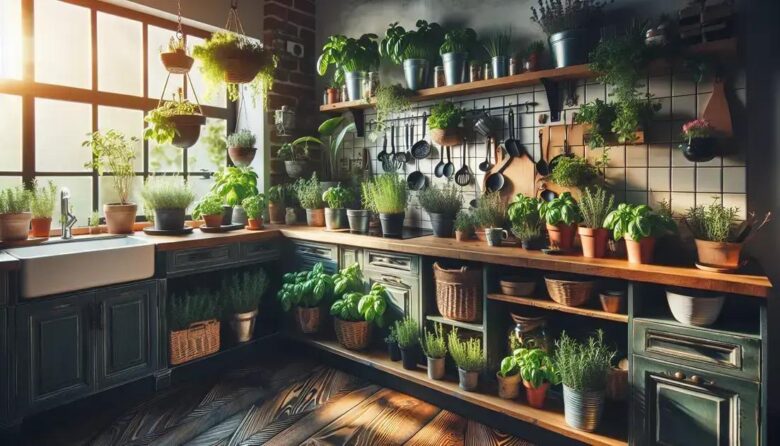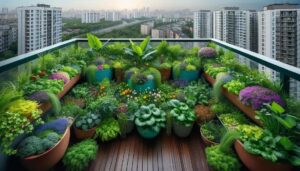An indoor herb bar in your kitchen uses containers like clay pots or glass jars to display herbs such as basil, mint, and rosemary, providing fresh, accessible ingredients and adding aesthetic appeal to your space. Ensure adequate sunlight and proper maintenance for optimal growth.
Creating an indoor herb bar using kitchen containers can turn your culinary space into a vibrant oasis. Imagine plucking fresh basil for your pasta directly from your countertop. Let’s explore how you can set up this green haven easily at home.
how to start your indoor herb bar
Starting an indoor herb bar in your kitchen is simpler than you might think. Begin by selecting a few of your favorite herbs, such as basil, mint, and cilantro. These herbs are not only easy to grow but also frequently used in a variety of dishes.
Selecting the Right Space
Choose a spot in your kitchen that receives abundant natural light, as herbs thrive on sunlight. A windowsill or a dedicated section of your countertop can be ideal locations.
Basic Supplies Needed
Gather the necessary supplies: pots or containers with proper drainage, quality potting soil, and herb seeds or young plants. A small watering pot is also handy to keep your plants hydrated.
With these simple steps, you can create your own indoor herb oasis, adding both beauty and flavor to your home.
essential herbs for your indoor garden
When selecting essential herbs for your indoor garden, consider both culinary and medicinal uses. Basil is a popular choice due to its versatility in cooking and easy cultivation. Mint is another must-have, perfect for teas and garnishes.
Additional Herb Options
Rosemary makes a great indoor plant with its aroma and hardiness. Thyme is another herb that thrives in pots, adding flavor to various dishes.
Don’t forget parsley, which is not just a garnish. It’s rich in vitamins and easy to grow on sunny windowsills. Chives provide a mild onion flavor and are ideal for garnishing salads or dishes.
These herbs require minimal care and provide fresh ingredients year-round, enhancing both your kitchen and your culinary endeavors.
choosing the right containers for herbs
Choosing the right containers for herbs is crucial for healthy plant growth. Consider both size and material. A container needs to be spacious enough to allow roots to expand. Small pots work for herbs like chives and cilantro, while larger ones are better for rosemary or mint.
Material Matters
Clay pots offer great drainage and breathability, preventing root rot. Ceramic pots add aesthetic appeal but might need a drainage layer. Try using recycled materials such as tin cans or glass jars to create an eco-friendly setup.
Ensure each container has sufficient drainage holes. Elevate pots with a saucer to protect surfaces from water overflow. These choices enhance your kitchen’s decor while supporting lush, flourishing herbs.
placement tips for optimizing growth
Optimizing herb growth starts with proper placement tips. First, identify a location with ample sunlight. Most herbs need at least six hours of sunlight per day. A south-facing window is ideal.
Temperature and Humidity
Avoid placing herbs near heat vents or drafts, which can impact growth negatively. Maintaining a consistent room temperature around 65-75°F is best. Herbs appreciate humidity, so misting them occasionally can help.
Rotate pots regularly to ensure even light exposure, which can prevent uneven growth and legginess. By following these tips, you can maximize the health and productivity of your indoor herb garden, ensuring robust plants year-round.
maintaining your indoor herb bar effortlessly
Maintaining your indoor herb bar can be simple with regular care. Watering is key; most herbs prefer soil that’s moist but not waterlogged. Use a light touch and check the soil’s top inch for dryness before watering.
Pruning and Fertilizing
Regular pruning encourages growth. Snip off leaves and stems regularly, focusing on older growth and using clean scissors. This not only promotes bushier plants but also provides you with fresh herbs for cooking.
Feed herbs with a mild, organic fertilizer every 4-6 weeks to ensure they receive the nutrients they need. Monitor for pests like aphids and use natural remedies to keep them at bay. With these simple steps, your herbs will thrive.
creative kitchen setups for stylish herb displays
Style your kitchen with creative setups for an appealing herb display. Consider using vertical gardening techniques. Wall-mounted planters are perfect for small spaces and save counter space while showcasing your herbs.
Innovative Display Ideas
Use a hanging garden with pots suspended from a sturdy rod. This approach can create a visually striking display that doubles as a partition or room highlight. Another idea is a tiered stand on your countertop, which adds dimension and keeps herbs within easy reach.
Choose unique containers such as colorful tins, glass jars, or even vintage teacups. Mixing and matching these can add a whimsical touch to your decor, making your kitchen both functional and beautiful.
Bringing Fresh Flair to Your Kitchen
Setting up an indoor herb bar transforms your kitchen into a vibrant and functional space. Whether you’re nurturing essential herbs, choosing the perfect containers, or discovering creative display methods, each step enriches your home environment with greenery and flavor.
Maintaining your herb garden becomes effortless with the right tips and placements, ensuring lush growth throughout the year. More than just utility, these herbs bring a touch of nature indoors, making your kitchen a focal point of freshness and style.
Embrace these creative ideas, and soon you’ll find your kitchen is not only a place for cooking but also a lively oasis of health and creativity.
FAQ – Frequently Asked Questions About Indoor Herb Bars
What are the best herbs to grow indoors?
Basil, mint, rosemary, thyme, and parsley are popular choices due to their versatility and ease of care.
Do herbs need sunlight indoors?
Yes, most herbs require at least six hours of sunlight daily. A south-facing window is ideal for optimal growth.
How often should I water my indoor herbs?
Water herbs when the top inch of soil feels dry. Avoid overwatering, as it can lead to root rot.
What type of containers are best for growing herbs?
Containers with good drainage like clay pots, ceramic, or recycled materials work well for herbs.
Can I grow herbs in a small kitchen?
Absolutely! Use wall-mounted planters, hanging gardens, or tiered stands to save space while displaying herbs.
How can I maintain my indoor herb bar effectively?
Regularly prune plants to encourage growth, use mild fertilizer, and monitor for pests to keep your herb garden thriving.



